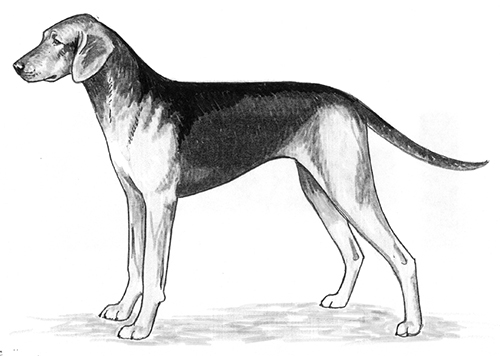Schiller Hound
Scenthound Group
The goals and purposes of this breed standard include: to furnish guidelines for breeders who wish to maintain the quality of their breed and to improve it; to advance this breed to a state of similarity throughout the world; and to act as a guide for judges.
Breeders and judges have the responsibility to avoid any conditions or exaggerations that are detrimental to the health, welfare, essence and soundness of this breed, and must take the responsibility to see that these are not perpetuated.
Any departure from the following should be considered a fault, and the seriousness with which the fault should be regarded should be in exact proportion to its degree and its effect upon the health and welfare of the dog and on the dog’s ability to perform its traditional work.
History
The Schiller Hound originated in Sweden. It is descended from Swiss hounds, along with an infusion of British hound blood, mostly Harrier. It was recognized by the Swedish KC in 1907. The breed is used for hunting fox and hare. It is not a pack hound.
The Schiller Hound was recognized by the United Kennel Club in 2006.
General Appearance
Well proportioned, sinewy and noble, giving the impression of speed and strength.
Characteristics
Lively and attentive.
Head
The head is fairly long. It is triangular in shape, but should never appear snipy.
SKULL
The skull is broadest between the ears. It is slightly arched. The stop is well defined.
MUZZLE
The muzzle is long, and the bridge is straight and parallel to the top of the skull. The lips are tight and close fitting. The cheeks are lean.
Fault: Dish face.
TEETH
The Schiller Hound has a complete set of evenly spaced, white teeth meeting in a scissors bite.
Faults: Any bite other than scissors.
NOSE
The black nose has well developed nostrils.
EYES
The eyes are dark brown, and have a lively expression.
Fault: Light eyes.
EARS
The high set ears are soft, and hang flat, with the forward edge close to the cheeks. They reach about half way along the muzzle when pulled forward.
Neck
The neck is long and powerful. Males should have a well defined arch at the crest.
Forequarters
The shoulder blades and upper arms are long and well laid back, forming a right angle.
FORELEGS
The legs are straight and parallel, and the elbows set close to the body. The bone is strong, and the pasterns are springy and slightly sloping.
Body
The body is slightly longer than it is tall. The well developed chest is deep, and the ribs are moderately sprung. The withers are well defined, and the back is strong and level. The loin is muscular and slightly arched, and the croup is long, broad and slightly sloping. There is a slight tuck up.
Hindquarters
The hindquarters are strong, muscular, and parallel when viewed from behind.
HIND LEGS
The stifle and hock joints are well angulated. The rear pasterns are short, lean and vertical.
Feet
The feet are oval in shape, with tight, well arched toes.
Tail
Set on a line with the back, the tail is broad at the base and tapers to the tip, which should reach to the hock. The tail is preferably carried not above the level of the back.
Coat
Harsh, not too short, and very close lying. The coat may be longer on the backs of the thighs and the underside of the tail.
Color
Tan base color with a well defined black mantle. Slight white markings on the chest and toes are acceptable. Black hair mingled in the tan is faulty in an adult. Black markings on the cheeks are permissible.
Fault: Undefined mantle with an infusion of tan hairs.
Height
The ideal height for males is 22.5 inches. For females, it is 21 inches.
Gait
Parallel, strong and long reaching.
Disqualifications
(A dog with a Disqualification must not be considered for placement in a conformation event, and must be reported to UKC.)
Unilateral or bilateral cryptorchid.
Viciousness or extreme shyness.
Albinism.

Looking for a Dog?
Find a dog that will fit your family.
Note: The breeders on this list are not endorsed by UKC.
©Copyright 2006, United Kennel Club
